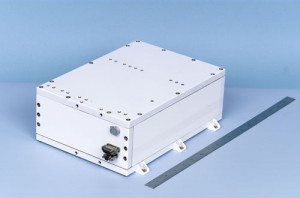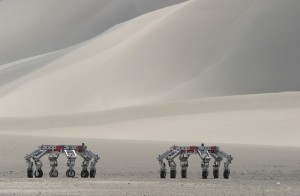“At the time Constellation was announced, it was almost purely a human spaceflight program and what I thought was an opportunity for the laboratories, or the staffs of the laboratories, to be participating in a human spaceflight program,” Sander said.
“That stretches our technical wings in a very real sense. The scale of the human spaceflight projects was typically much larger than the typical robotic space project. Learning how to do business in just a huge human space project environment, I think, has been a lesson.”
Working together
NASA learned the lesson that even robotic missions aren’t immune to the destructive effects of intense cosmic radiation when it launched its 2001 Mars Odyssey on April 7, 2001. The spacecraft was designed to measure radiation on the way to Mars and in Martian orbit. On board was a sophisticated device called the Martian Radiation Environment Experiment, or MARIE.
The 7.3-pound suitcase-sized MARIE started malfunctioning in late 2003 after a series of particularly strong solar flares blasted the spacecraft and instrument with powerful radiation. MARIE was toasted. The solar proton event that disabled MARIE was not detected on Earth, meaning that the radiation was directional and, therefore, impossible to predict to warn astronauts. These phenomena could have a deleterious effect on any manned missions to Mars.
Sander said that the human space flight versus robotic missions isn’t an either/or argument and points to JPL’s six-legged ATHLETE rover as an example of robots interacting with humans on the moon. ATHLETE stands for All-Terrain Hex-Legged Extra-Terrestrial Explorer, and it can roll or climb across extraterrestrial terrain more than 100 times faster than the wheeled Mars Exploration Rovers.
“I would say that it’s a breakthrough in terms of its flexibility and capability,” said Sander. “By participating in the exploration technology program, we’re able to create it, test it and put a couple of generations of capability in place, take it out in field trials, work cooperatively with other similar products with other NASA centers to see how all of these humans plus robots working together can carry out an exploration campaign. That’s really been extraordinary.”
Extraordinary indeed. ATHLETE could someday rappel down lunar cliffs to look for water in the permanent shadows of the moon’s craters, where temperatures are 369 degrees Fahrenheit below zero, enabling robots to accomplish the goals pushed by Bush.
“Also the moon is home to abundant resources,” Bush said in 2004. “Its soil contains raw materials that might be harvested and processed into rocket fuel or breathable air.”
Bush’s blurry vision missed the fact that our planet has abundant resources, including plenty of air, water and rocket fuel. Indeed, ATHLETE can be independently launched and deployed, with no astronaut presence needed, and be driven from the comfy confines of JPL, safely shielded from withering cosmic radiation by our planet’s atmosphere.
ATHLETE’s principal investigator, Brian Wilcox, enthuses in a JPL video about the rover’s robust capabilities. “The [human] operator — it’s as if they are standing in the middle of the vehicle,” he says, “looking out everywhere in every direction.”
If Obama’s NASA budget prevails, the agency will flourish with big-bang-for-the-buck robotics, freed from Cold War-era initiatives made obsolete by today’s cutting-edge technology created in Southern California.
To read the entire Mike Sander interview, see more photos and videos, or contact the author, go to EnviroReporter.com.












Supe-fantastic, Michael. Your article has left me speechless…well, almost. I can absolutely visualize the movie right now. You have left Avatar in the dust!
Why can’t we rent that robot to dig up the SSFL and ship all of the contamination to the moon?